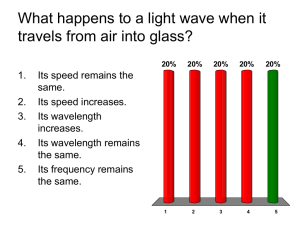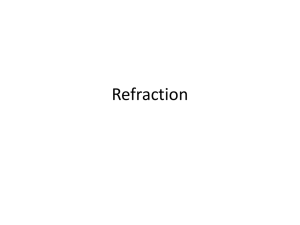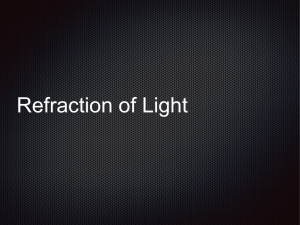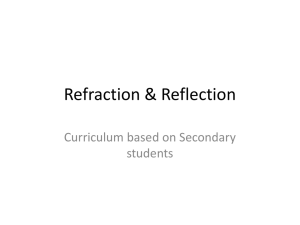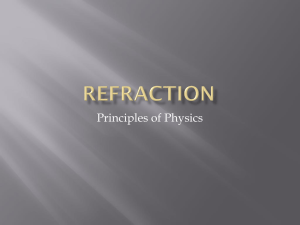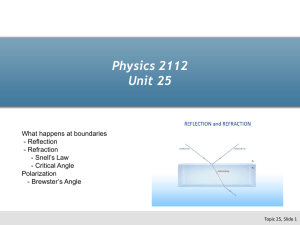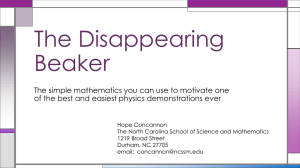Chapter 22 Powerpoint
advertisement
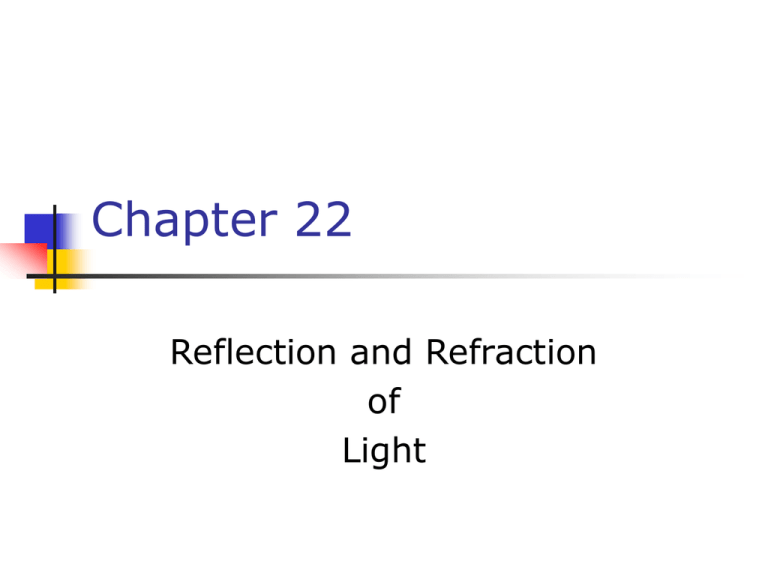
Chapter 22 Reflection and Refraction of Light A Brief History of Light 1000 AD Newton It was proposed that light consisted of tiny particles Used this particle model to explain reflection and refraction Huygens 1678 Explained many properties of light by proposing light was wave-like A Brief History of Light, cont Young 1801 Strong support for wave theory by showing interference Maxwell 1865 Electromagnetic waves travel at the speed of light A Brief History of Light, final Planck EM radiation is quantized Implies particles Explained light spectrum emitted by hot objects Einstein Particle nature of light Explained the photoelectric effect The Particle Nature of Light “Particles” of light are called photons Each photon has a particular energy E=hƒ h is Planck’s constant h = 6.63 x 10-34 J s Encompasses both natures of light Interacts like a particle Has a given frequency like a wave Dual Nature of Light Experiments can be devised that will display either the wave nature or the particle nature of light In some experiments light acts as a wave and in others it acts as a particle Nature prevents testing both qualities at the same time Geometric Optics – Using a Ray Approximation Light travels in a straight-line path in a homogeneous medium until it encounters a boundary between two different media The ray approximation is used to represent beams of light A ray of light is an imaginary line drawn along the direction of travel of the light beams Ray Approximation A wave front is a surface passing through points of a wave that have the same phase and amplitude The rays, corresponding to the direction of the wave motion, are perpendicular to the wave fronts Example 1 Albert A. Michelson very carefully measured the speed of light using an alternative version of the technique developed by Fizeau. Figure P22.4 shows the approach Michelson used. Light was reflected from one face of a rotating eight-sided mirror towards a stationary mirror 35.0 km away. At certain rates of rotation, the returning beam of light was directed toward the eye of an observer as shown. (a) What minimum angular speed must the rotating mirror have in order that side A will have rotated to position B, causing the light to be reflected to the eye? (b) What is the nexthigher angular velocity that will enable the source of light to be seen? Reflection of Light A ray of light, the incident ray, travels in a medium When it encounters a boundary with a second medium, part of the incident ray is reflected back into the first medium This means it is directed backward into the first medium Specular Reflection Specular reflection is reflection from a smooth surface The reflected rays are parallel to each other All reflection in this text is assumed to be specular Diffuse Reflection Diffuse reflection is reflection from a rough surface The reflected rays travel in a variety of directions Diffuse reflection makes the dry road easy to see at night Law of Reflection The normal is a line perpendicular to the surface It is at the point where the incident ray strikes the surface The incident ray makes an angle of θ1 with the normal The reflected ray makes an angle of θ1’ with the normal Law of Reflection, cont The angle of reflection is equal to the angle of incidence θ1= θ1’ Quick Quiz Which part of Figure 22.3, (a) or (b), better shows specular reflection of light from the roadway? Refraction of Light When a ray of light traveling through a transparent medium encounters a boundary leading into another transparent medium, part of the ray is reflected and part of the ray enters the second medium The ray that enters the second medium is bent at the boundary This bending of the ray is called refraction Refraction of Light, cont The incident ray, the reflected ray, the refracted ray, and the normal all lie on the same plane The angle of refraction, θ2, depends on the properties of the medium Following the Reflected and Refracted Rays Ray is the incident ray Ray is the reflected ray Ray is refracted into the lucite Ray is internally reflected in the lucite Ray is refracted as it enters the air from the lucite More About Refraction The angle of refraction depends upon the material and the angle of incidence sin1 v2 constant sin2 v1 The path of the light through the refracting surface is reversible Refraction Details, 1 Light may refract into a material where its speed is lower The angle of refraction is less than the angle of incidence The ray bends toward the normal Refraction Details, 2 Light may refract into a material where its speed is higher The angle of refraction is greater than the angle of incidence The ray bends away from the normal The Index of Refraction When light passes from one medium to another, it is refracted because the speed of light is different in the two media The index of refraction, n, of a medium can be defined speed of light in a vacuum c n speed of light in a medium v Frequency Between Media As light travels from one medium to another, its frequency does not change Both the wave speed and the wavelength do change The wavefronts do not pile up, nor are created or destroyed at the boundary, so ƒ must stay the same Index of Refraction Extended The frequency stays the same as the wave travels from one medium to the other v=ƒλ The ratio of the indices of refraction of the two media can be expressed as various ratios c 1 v1 n1 n2 c 2 v2 n1 n2 Index of Refraction, cont For a vacuum, n = 1 For other media, n > 1 n is a unitless ratio Some Indices of Refraction Snell’s Law of Refraction n1 sin θ1 = n2 sin θ2 θ1 is the angle of incidence 30.0° in this diagram θ2 is the angle of refraction Quick Quiz If beam 1 is the incoming beam in Active Figure 22.6b, which of the other four beams are due to reflection? Which are due to refraction? Quick Quiz A material has an index of refraction that increases continuously from top to bottom. Of the three paths shown in Figure 22.10, which path will a light ray follow as it passes through the material? Quick Quiz As light travels from a vacuum (n = 1) to a medium such as glass (n > 1), which of the following properties remains the same? (a) wavelength, (b) wave speed, or (c) frequency? Example 2 Light is incident normal to a 1.00-cm layer of water that lies on top of a flat Lucite® plate with a thickness of 0.500 cm. How much more time is required for light to pass through this double layer than is required to traverse the same distance in air (nLucite = 1.59)? Example 3 Light of wavelength 436 nm in air enters a fishbowl filled with water, then exits through the crown-glass wall of the container. Find the wavelengths of the light (a) in the water and (b) in the glass. Example 4 The light emitted by a helium–neon laser has a wavelength of 632.8 nm in air. As the light travels from air into zircon, find (a) its speed in zircon, (b) its wavelength in zircon, and (c) its frequency. Practice 1 A flashlight on the bottom of a 4.00-m-deep swimming pool sends a ray upward and at an angle so that the ray strikes the surface of the water 2.00 m from the point directly above the flashlight. What angle (in air) does the emerging ray make with the water’s surface? Dispersion The index of refraction in anything except a vacuum depends on the wavelength of the light This dependence of n on λ is called dispersion Snell’s Law indicates that the angle of refraction made when light enters a material depends on the wavelength of the light Variation of Index of Refraction with Wavelength The index of refraction for a material usually decreases with increasing wavelength Violet light refracts more than red light when passing from air into a material Refraction in a Prism The amount the ray is bent away from its original direction is called the angle of deviation, δ Since all the colors have different angles of deviation, they will spread out into a spectrum Violet deviates the most Red deviates the least Prism Spectrometer A prism spectrometer uses a prism to cause the wavelengths to separate The instrument is commonly used to study wavelengths emitted by a light source Using Spectra to Identify Gases All hot, low pressure gases emit their own characteristic spectra The particular wavelengths emitted by a gas serve as “fingerprints” of that gas Some uses of spectral analysis Identification of molecules Identification of elements in distant stars Identification of minerals The Rainbow A ray of light strikes a drop of water in the atmosphere It undergoes both reflection and refraction First refraction at the front of the drop Violet light will deviate the most Red light will deviate the least The Rainbow, 2 At the back surface the light is reflected It is refracted again as it returns to the front surface and moves into the air The rays leave the drop at various angles The angle between the white light and the violet ray is 40° The angle between the white light and the red ray is 42° Observing the Rainbow If a raindrop high in the sky is observed, the red ray is seen A drop lower in the sky would direct violet light to the observer The other colors of the spectra lie in between the red and the violet Example 5 A certain kind of glass has an index of refraction of 1.650 for blue light of wavelength 430 nm and an index of 1.615 for red light of wavelength 680 nm. If a beam containing these two colors is incident at an angle of 30.00° on a piece of this glass, what is the angle between the two beams inside the glass? Christian Huygens 1629 – 1695 Best known for contributions to fields of optics and dynamics Deduced the laws of reflection and refraction Explained double refraction Huygen’s Principle Huygen assumed that light is a form of wave motion rather than a stream of particles Huygen’s Principle is a geometric construction for determining the position of a new wave at some point based on the knowledge of the wave front that preceded it Huygen’s Principle, cont All points on a given wave front are taken as point sources for the production of spherical secondary waves, called wavelets, which propagate in the forward direction with speeds characteristic of waves in that medium After some time has elapsed, the new position of the wave front is the surface tangent to the wavelets Huygen’s Construction for a Plane Wave At t = 0, the wave front is indicated by the plane AA’ The points are representative sources for the wavelets After the wavelets have moved a distance cΔt, a new plane BB’ can be drawn tangent to the wavefronts Huygen’s Construction for a Spherical Wave The inner arc represents part of the spherical wave The points are representative points where wavelets are propagated The new wavefront is tangent at each point to the wavelet Huygen’s Principle and the Law of Reflection The Law of Reflection can be derived from Huygen’s Principle AA’ is a wave front of incident light The reflected wave front is CD Huygen’s Principle and the Law of Reflection, cont Triangle ADC is congruent to triangle AA’C θ1 = θ1’ This is the Law of Reflection Huygen’s Principle and the Law of Refraction In time Δt, ray 1 moves from A to B and ray 2 moves from A’ to C From triangles AA’C and ACB, all the ratios in the Law of Refraction can be found n1 sin θ1 = n2 sin θ2 Total Internal Reflection Total internal reflection can occur when light attempts to move from a medium with a high index of refraction to one with a lower index of refraction Ray 5 shows internal reflection Critical Angle A particular angle of incidence will result in an angle of refraction of 90° This angle of incidence is called the critical angle n2 sin C for n1 n2 n1 Critical Angle, cont For angles of incidence greater than the critical angle, the beam is entirely reflected at the boundary This ray obeys the Law of Reflection at the boundary Total internal reflection occurs only when light attempts to move from a medium of higher index of refraction to a medium of lower index of refraction Fiber Optics An application of internal reflection Plastic or glass rods are used to “pipe” light from one place to another Applications include medical use of fiber optic cables for diagnosis and correction of medical problems Telecommunications Example 6 Calculate the critical angles for the following materials when surrounded by air: (a) zircon, (b) fluorite, and (c) ice. Assume that λ = 589 nm. Practice 2 A plastic light pipe has an index of refraction of 1.53. For total internal reflection, what is the minimum angle of incidence if the pipe is in (a) air? (b) water?


